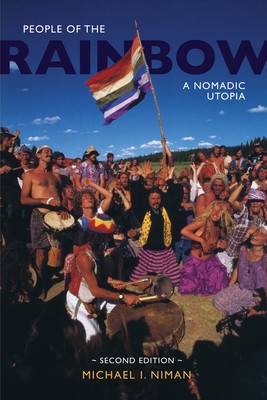
- We will send in 10–14 business days.
- Author: Michael I Niman
- Publisher: Univ Tennessee Press
- Pages: 336
- ISBN-10: 157233746X
- ISBN-13: 9781572337466
- Format: 15 x 22.9 x 2.3 cm, minkšti viršeliai
- Language: English
- SAVE -10% with code: EXTRA
Reviews
Description
Since 1972 the Rainbow Family of Living Light, a loosely organized and anarchistic nomadic community, has been holding large gatherings in remote forests to pray for world peace and create a model of a functioning utopian society. Michael I. Niman's People of the Rainbow, originally published in 1997, was the first comprehensive study of this countercultural group and its eclectic philosophy of environmentalism, feminism, peace activism, group sharing, libertarianism, and consensus government. It is a book yet to be superseded.
This second edition of Niman's compelling and insightful work brings the Rainbow story up to date with a new introduction and two extensive new epilogues. While the big annual Rainbow "Gatherings" have drawn fewer numbers in recent years, Niman notes, the Rainbow ethos has in many ways migrated to the mainstream, as Rainbow notions about alternative medicine and environmental sustainability, for example, have gathered wider acceptance and influenced the national dialogue. Meanwhile, Rainbow movements in other regions, from Eastern Europe and the Middle East to Asia and Australia, are thriving. In addition to addressing changes within the Rainbow Family and its complex relationshipto "Babylon" (what Rainbows call mainstream culture), the book's new material explores the growing harassment Rainbows now face from U.S. law enforcement agencies--
especially those associated with the National Forest Service. As Niman contends, this particular saga of a U.S. bureaucracy at war with its own citizens is a subplot in the larger--and disturbing--story of how the relationship between Americans and their government has changed during the first decade of the twenty-first century. In its nuanced portrait of an intriguing subculture, its successes, and its limitations, People of the Rainbow remains a significant contribution to the study of utopian communities in the United States and their ongoing legacy. Michael I. Niman is a professor of journalism and media studies in the Communication Department at Buffalo State College in New York.
For additional resources related to this new edition, see http: //buffalostate.edu/peopleoftherainbow.
EXTRA 10 % discount with code: EXTRA
The promotion ends in 21d.02:18:52
The discount code is valid when purchasing from 10 €. Discounts do not stack.
- Author: Michael I Niman
- Publisher: Univ Tennessee Press
- Pages: 336
- ISBN-10: 157233746X
- ISBN-13: 9781572337466
- Format: 15 x 22.9 x 2.3 cm, minkšti viršeliai
- Language: English English
Since 1972 the Rainbow Family of Living Light, a loosely organized and anarchistic nomadic community, has been holding large gatherings in remote forests to pray for world peace and create a model of a functioning utopian society. Michael I. Niman's People of the Rainbow, originally published in 1997, was the first comprehensive study of this countercultural group and its eclectic philosophy of environmentalism, feminism, peace activism, group sharing, libertarianism, and consensus government. It is a book yet to be superseded.
This second edition of Niman's compelling and insightful work brings the Rainbow story up to date with a new introduction and two extensive new epilogues. While the big annual Rainbow "Gatherings" have drawn fewer numbers in recent years, Niman notes, the Rainbow ethos has in many ways migrated to the mainstream, as Rainbow notions about alternative medicine and environmental sustainability, for example, have gathered wider acceptance and influenced the national dialogue. Meanwhile, Rainbow movements in other regions, from Eastern Europe and the Middle East to Asia and Australia, are thriving. In addition to addressing changes within the Rainbow Family and its complex relationshipto "Babylon" (what Rainbows call mainstream culture), the book's new material explores the growing harassment Rainbows now face from U.S. law enforcement agencies--
especially those associated with the National Forest Service. As Niman contends, this particular saga of a U.S. bureaucracy at war with its own citizens is a subplot in the larger--and disturbing--story of how the relationship between Americans and their government has changed during the first decade of the twenty-first century. In its nuanced portrait of an intriguing subculture, its successes, and its limitations, People of the Rainbow remains a significant contribution to the study of utopian communities in the United States and their ongoing legacy. Michael I. Niman is a professor of journalism and media studies in the Communication Department at Buffalo State College in New York.
For additional resources related to this new edition, see http: //buffalostate.edu/peopleoftherainbow.


Reviews